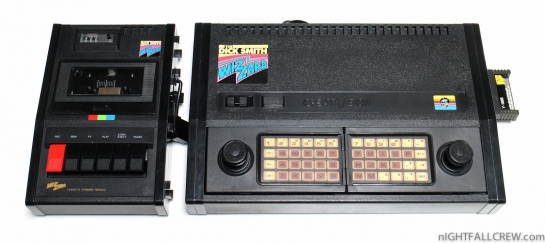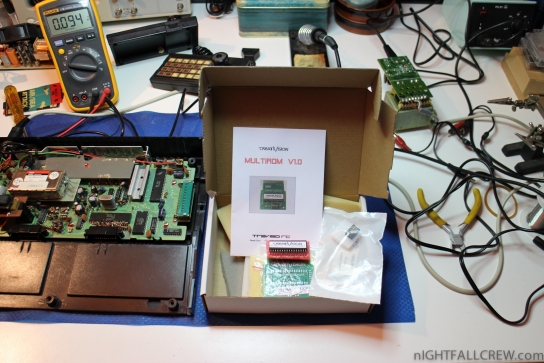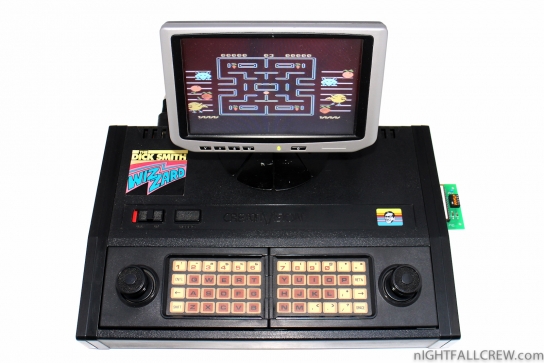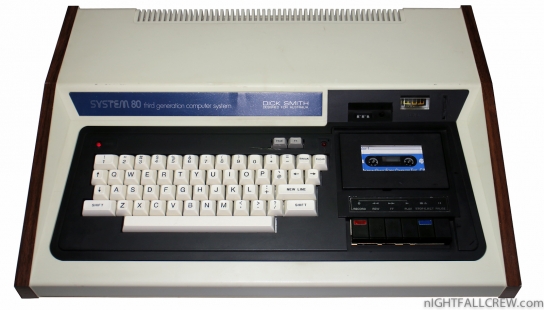
Gallery:
The Dick Smith Wizzard (Creativision) Cassette Storage Module is a mass storage expansion for the Dick Smith Wizzard.
Using the Dick Smith Wizzard Basic allow you to load and save program which you enter in the computer. By recording a program on a tape, you can save it as permanent record. Later you can load the program from cassette tape into the computer’s memory if you want to use that program again.
Cassette Storage Module – Tape Loading:
source: madrigaldesign.it

The Creativision console was given to me on loan from a friend, Andrea Pierdomenico for testing the MultiROM v1.0 cartridge made by Treviso RC (Francesco Brolli)
I and Andrea we realized that the power supply was lost (tragedy). The original power supply of the CreatiVision uses 16v in AC 350ma and 9v in AC 1amp.
Here comes Ciro (Ninetyniner Iuc) that months ago gave me a transformer extirpated from a unknown motherboard and with a bit of fortune there are all voltages.
At this point, given the poor quality of the output video via antenna that comes with the Creativision i have decided to make the easy Composite Video/Audio mod and acting on the Trimmer (color gain) native on the PCB of Creativision i have reached a good quality of the image.
I must thank Andrea Pierdomenico, Ninetyniner Iuc and Francesco Brolli (Treviso RC) for the MultiROM Cartridge v1.0.
Gallery:

Gallery:
The Video Technology CreatiVision was a hybrid computer and home video game console introduced by VTech in 1981. The hybrid unit was similar in concept to computers such as the APF Imagination Machine, the older VideoBrain Family Computer, and to a lesser extent the Intellivision game console and Coleco Adam computer, all of which anticipated the trend of video game consoles becoming more like low-end computers.
The CreatiVision was distributed in many European countries, in South Africa, in Israel under the Educat 2002 name, as well as in Australia under the Dick Smith Wizzard name. Other names for the system (all officially produced by VTech themselves) include the FunVision Computer Video Games System, Hanimex Rameses and VZ 2000. All CreatiVision and similar clones were designed for use with PAL standard television sets, except the Japanese CreatiVision (distributed by Cheryco) which was NTSC and is nowadays much sought after by collectors.
The CreatiVision console sported an 8-bit Rockwell 6502 CPU at a speed of 2 MHz, 1KB of RAM and 16KB of Video RAM, and had a graphics resolution of 256 × 192 with 16 colors and 32 sprites. The console had 2 integrated joystick/membrane keypad controllers (much like the ColecoVision) which, when set in a special compartment on top of the console, could be used as a computer keyboard. The CreatiVision had interfaces for a cassette player, an extra rubber keyboard, floppy disk drive, parallel I/O interface, modem (likely unreleased), Centronics printer and one memory expansion module for use with the Basic language cartridge.
The CreatiVision was discontinued in late 1985/early 1986. A computer was produced by VTech in 1984-1986, based on CreatiVision hardware and compatible with most of the games: Laser 2001, which sold in Europe and Australia. It was also available in Finland through Salora, with the name of Manager. The Manager had a specific keyboard with Finnish layout and character set.
source: wikipedia

Video Genie (or simply Genie) was a series of computers produced by Hong Kong-based manufacturer EACA during the early 1980s. They were compatible with the Tandy TRS-80 Model I computers and could be considered a clone, although there were hardware and software differences.
The computers making up the series were:
- Video Genie System (EG3003 – first version, early/mid 1980)
- Video Genie System (EG3003 – second version, late 1980)
- Genie I (EG3003 – third version, late 1981)
- Dick Smith System 80 MK I (EG3003)
- Genie II (EG3008 – late 1981)
- Disk Smith System 80 MK II (EG3008)
- Genie III (EG3200 – mid 1982) – a more business-oriented machine with CP/M-compatibility.
Although Video Genie was the name used in Western Europe, the machines were sold under different names in other countries.
In Australia and New Zealand they were known as the Dick Smith System 80 MK I (EG3003) and System 80 MK II (EG3008), and in North America they were sold as the PMC-80 and PMC-81. In South Africa the Video Genie was sold as the TRZ-80, a name similar to its rival.
In early 1983, the related Colour Genie machine was released by EACA.
Features:
- CPU: Zilog Z80, at 1.76 MHz
- Video: Monochrome
- 64×16 / 32×16 uppercase text
- 128×48 block graphics
- Composite video output, cable included
- RF TV signal output, cable included
- 16 KB RAM, expandable to 48 KB
- 12 KB ROM containing Microsoft LEVEL II BASIC
- Storage: Built in 500 baud cassette deck
- Cable for using an external cassette deck included
- Built in powersupply
Autopsy:
source: wikipedia












































Recent Comments